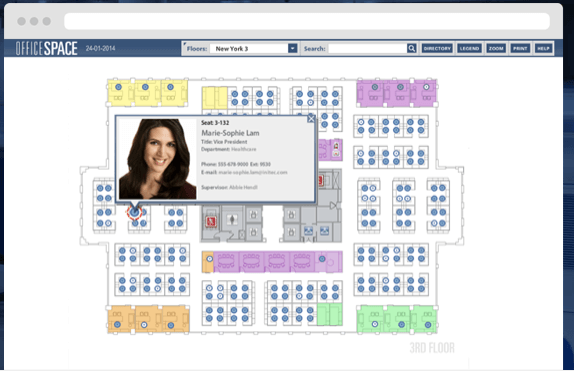How Businesses Use OfficeSpace
Earlier this year, Work Design Magazine posted an interview with me and two other OfficeSpace users: Andrew Barret-Weiss, the Workplace Experience Manager at car shopping site Edmunds.com, and Opher Lichter, the Worldwide Systems Director at advertising firm Young & Rubicam.
For Edmunds.com, who was hiring five to 10 people every two weeks at the time of the article’s publication, OfficeSpace helped employees find each other and provided a useful visual resource for visitors. It also allowed employees to easily see emergency evacuation routes, reserve conference rooms and connect to printers remotely.
Young & Rubicam, who used OfficeSpace to move a company of 1,800 over four weekends, installed touch-screen televisions displaying the Visual Directory™ on every lobby. According to Opher, “It made total sense to have the Visual Directory™ as the main content on the screens in every lobby, with any time-sensitive content or messaging being overlaid on top.”
An excerpt from the article is below.
What are some of the immediate perks of using a space allocation and management software like OfficeSpace?
Andrew: Edmunds.com is going through a growth period bringing on 5-10 people every two weeks. We’re using the software daily to determine seating assignments, to facilitate moves, and to better organize and plan for our continued expansion. We’re also using it to locate employees, to provide guests with information on where they can find someone, and to keep track of our headcount by location. We’ve also used it to provide information to employees on emergency evacuation routes, allow people to click on links in the directory to reserve conference rooms or connect to a printer from a remote location, and we’re providing photos so co-workers are more easily recognizable in the hallways. When we roll out the Visual Directory™, we’ll allow everyone to use the mapping functionality to find and connect with co-workers across all departments. Because we’ve been able to incorporate a map of all employees across the U.S. it is a much better way for us to visually demonstrate where our employees are based and how they contribute to the company’s footprint.
David: We make it incredibly easy to track and manage your space from a floor plan perspective. When it comes to facility management tools, we find that companies tend to fall into two categories: some type of paper/pencil/Excel process, or some variation of a CAD-heavy solution. We’ve found that both approaches can be painfully cumbersome.
OfficeSpace was designed with an emphasis on user experience. Facility managers can drag-drop their organization to their satisfaction, and OfficeSpace automatically handles move notification e-mails. There’s also Visual Directory™, an organization-wide tool that lets people effortlessly find co-workers, or company resources like printers, copiers conference rooms, etc. There are reports, custom integration API’s, and many other layers of functionality, but we have not tried to do everything for everyone. We’ve deliberately focused on a sweet spot of functionality, with the idea that if designed well enough, it will provide real value to organizations, rather than a system that attempts to do everything, but much of it poorly.
To hear more of Andrew’s and Opher’s thoughts on OfficeSpace, read the complete article here




